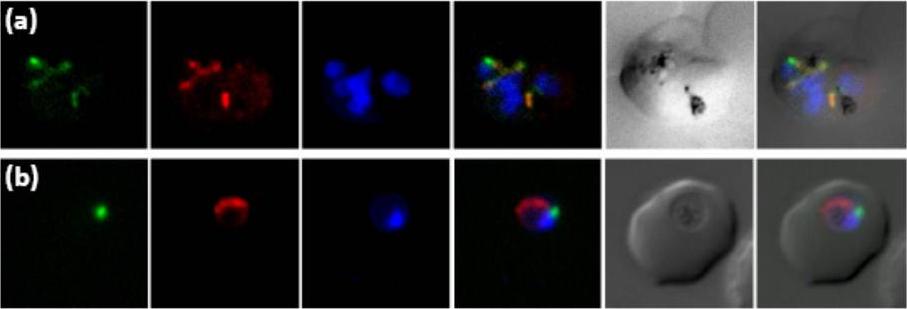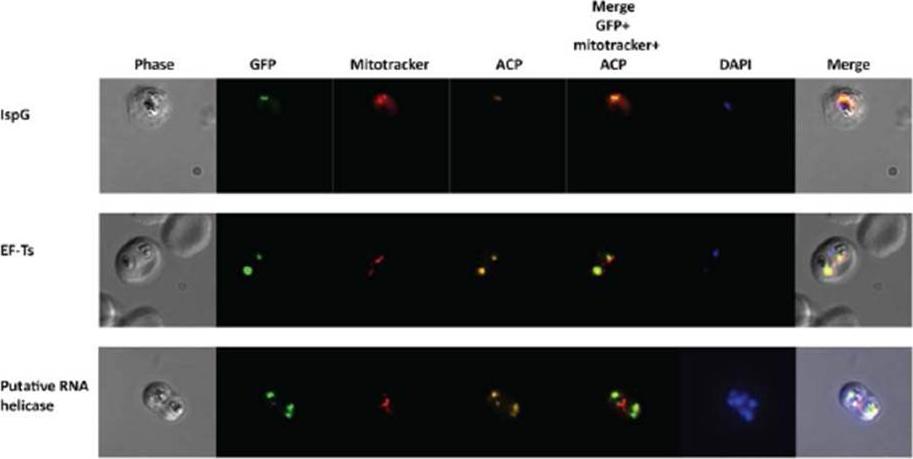PY17X_0405700 elongation factor (EF-TS), putative (EF-Ts)
Disruptability [+]
| Species | Disruptability | Reference | Submitter | |
|---|---|---|---|---|
| P. berghei ANKA |
Refractory |
PlasmoGEM (Barseq) | PlasmoGEM | |
| P. falciparum 3D7 |
Refractory |
USF piggyBac screen (Insert. mut.) | USF PiggyBac Screen | |
Mutant phenotypes [+]
None reported yet. Please press the '+' button above to add one.Imaging data (from Malaria Metabolic Pathways)

Plasmodium falciparum nuclear-encoded translation elongation factor (PfEF)-Ts detection and localisation. (A) PfEF-Ts is recognised in the parasite lysate in western blots using purified anti-PfEFTsexon1 antibody (Ab) (I). Both a larger (~46 kDa) and smaller (39 kDa) form are seen, likely representing a longer form without signal peptide, and a shorter form further processed to remove the transit peptide. No signal was observed when the parasite lysate was probed with pre-immune serum (PI). (B) The PfEF-Ts bipartite leader (amino acids 1-56) was fused to GFP and expressed from stable episomes in intraerythrocytic stages. (a) The PfEF-Tsleader-GFP (green) co-localised with antisera against the apicoplast protein ACP (red). In trophozoites (shown here) and schizonts, the PfEF-Tsleader- GFP labeled the branching, dividing and then segregating apicoplast. (b) Co-staining with mitochondrial dye mitotracker red. No localisation was observed between the PfEF-Tsleader-GFP (green) and Mitotracker (red), indicating that PfEF-Ts is solely targeted to the apicoplast. In both panels, the nucleus is stained using DAPI (blue). (C) Western blot of P. falciparum 3D7 cells transfected with the PfEF-Tsleader-GFP confirms N-terminal cleavage of the fusion protein. Anti-GFP antibody recognised 31 kDa and 28 kDa bands in transfected cells representing transit peptide containing GFP and the transit peptide-cleaved form with ~10 amino acids in front of GFP, respectively. No signals were observed in untransfected 3D7 cells or red blood cells (RBCs) alone. Biswas S, Lim EE, Gupta A, Mir SS, Siddiqi MI, Ralph SA, Habib S. Interaction of apicoplast-encoded elongation factor (EF) EF-Tu with nuclear-encoded EF-Ts mediates translation in the Plasmodium falciparum plastid. Int J Parasitol. 2010 41(3-4):417-27. Copyright Elsevier 2011
See original on MMP
Expression and localization of Kae1api interaction partners. Representative IFA images from RFA-tagged parasites are shown. IspG (top row), EF-Ts (middle row), and a putative RNA helicase (bottom row) co-localize with an apicoplast marker (ACP) and not with mitochondria. Mitochondria and nuclei were visualized with Mitotracker and DAPI-DNA stain, respectively. IFAstudies confirmed the apicoplast localization of all three proteins.Mallari JP, Oksman A, Vaupel B, Goldberg DE. Kinase-Associated Endopeptidase 1 (Kae1) Participates in an Atypical ribosome-Aassociated complex in the apicoplast of Plasmodium falciparum. J Biol Chem. 2014 Sep 9 [Epub ahead of print]
See original on MMPMore information
| PlasmoDB | PY17X_0405700 |
| GeneDB | PY17X_0405700 |
| Malaria Metabolic Pathways | Localisation images Pathways mapped to |
| Previous ID(s) | null |
| Orthologs | PBANKA_0403500 , PCHAS_0404400 , PF3D7_0305000 , PKNH_0838100 , PVP01_0835200 , PVX_119375 |
| Google Scholar | Search for all mentions of this gene |